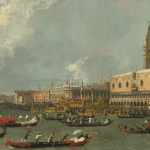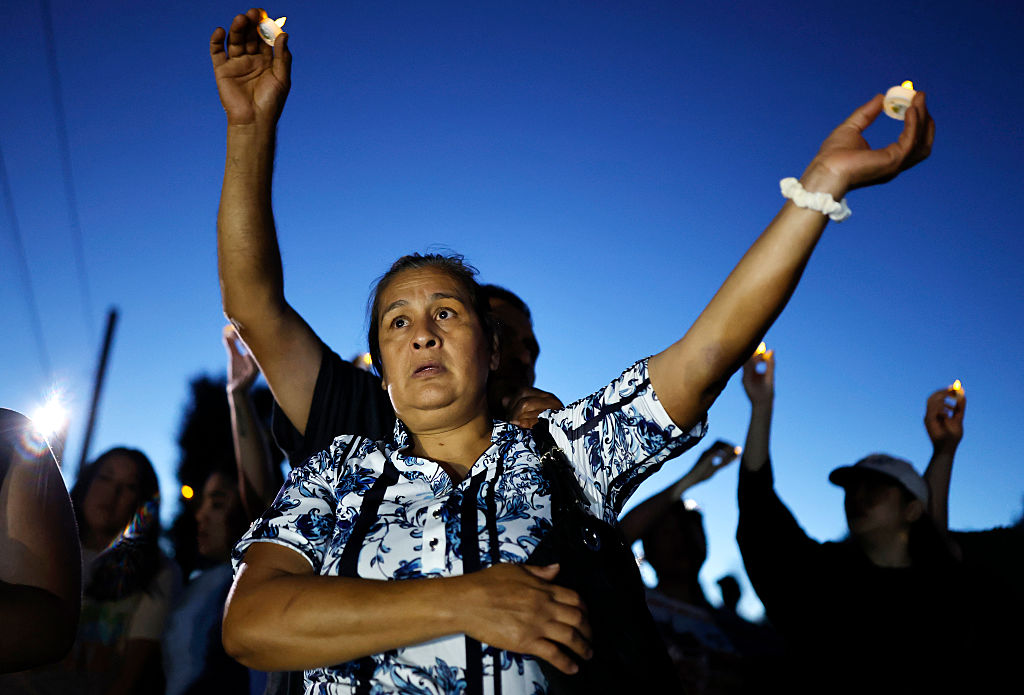Good Morning!
- Greenpeace activists unfurl massive, bloody Anish Kapoor work on the side of an oil rig.
- London’s Imperial War Museum accused of “soft Holocaust distortion.”
- Family of late mixed-media artist John Outterbridge has been sifting through charred ruins of his house, which burned down in the Greater Los Angeles fires earlier this year.
The Headlines
HIGH STEAKS, HIGH SEAS. Greenpeace activists have climbed a gas rig in the North Sea and unfurled a 315-square-foot, crimson-stained canvas down its side, in a dramatic protest created in collaboration with artist Anish Kapoor. The installation is believed to be the first artwork ever displayed on an active gas extraction platform. “I call it Butchered,” the British sculptor told the Guardian. “It represents the butchering of our environment. At its core, it’s blood on a canvas—a symbol of the destruction, the bleeding, of our planet and our very state of existence.” The protest took place early Wednesday after Greenpeace activists, having waited for ideal weather, approached the Shell-operated Skiff rig aboard the Arctic Sunrise, 45 nautical miles off the coast of Norfolk.
Related Articles

UNCOMFORTABLE TRUTHS. As Breakfast With ARTnews noted earlier this week, London’s Imperial War Museum has been criticized for refusing to change an information board in its Holocaust Galleries that two eminent historians say is incorrect. The Spectator has now weighed in, writing that while the “inaccuracy” relating to the Nuremberg race laws passed by the Nazi regime in Germany in 1935 may seem like a minor detail, it is a serious misrepresentation—and one with significant consequences. “It reflects a growing pattern of soft Holocaust distortion—not outright denial, but something subtler, a steady sanding down of uncomfortable truths,” the magazine writes.
The Digest
An international team of researchers, led by Yamagata University in Japan and IBM, in partnership with Peruvian experts, has announced the discovery of 248 newly identified geoglyphs among the renowned Nazca Lines. [The Art Newspaper]
In a new piece for the Financial Times, Julia Fawcett, CEO of the Lowry arts center in Manchester, U.K., makes the case for why immersive art is more than an “unimaginative” “money grab” that pulls funding and audiences away from “real” art. [FT]
Patients at London’s Royal Bethlem psychiatric hospital were once “gawked at” by the public, but now they’re being praised for their art. [The Times]
A new research project conducted by academics at the University of Toronto and the University of Bristol attempted to train an AI model to emulate human responses to famous artowrks. [The Economist]
The Kicker
SALVAGE & REDEMPTION. The Eaton Fire, which ripped through Altadena, California, in January 2025, led to significant cultural and historical loss. The family house of the late mixed-media artist John Outterbridge was in the firing line. The Los Angeles Times reports that his daughter, Tami , who was living in it at the time but luckily escaped unharmed, is now sifting through the charred ruins with a group of artists in the hope of salvaging some of her father’s artworks, archives, and personal possessions so they can build a work to honor him. “It occurred to me that I could invite artists who were in the direct line of contact with my father to come to the property and to excavate with me,” she recalled. “Not only would they help me find things, but also they create a piece with what they found that could be a reflection upon … this man that we called ‘Bridge.’” Time is up; today, the Army Corps of Engineers was due to clear the rubble on Thursday. “I feel like Dad is saying: ‘I have taught you this language. Now speak it,’” Tami said. “There’s this language of the discarded thing. The language of transformation and redemption. This all feels very redemptive to me.”
